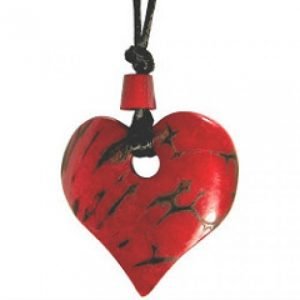Vegetable Ivory Bracelets

The Tagua Nut can be carved like ivory and dyed to create vibrant or subtle colors. It can look like wood, ivory, or 1980s neon jewelry! And best of all – it’s eco-friendly!
I love the look of this “ivory nut” used as beads for bracelets. I’m not a fan of plastic jewelry. It’s just not real. Even if it’s not cheap, I don’t feel comfortable in jewelry of unknown manufactured origin – but the colors they can make are gorgeous. That’s why I love Tagua Nut jewelry so much. Tagua can be dyed to be all sorts of beautiful colors and still feel real.
There are so many reasons to choose this material for jewelry in your collection – it’s environmentally responsible, socially responsible, and animal-friendly. That’s a jewelry hat trick!
5 Reasons Tagua Nut is an Eco-Friendly and Socially Responsible Choice
- Tagua Nut is a renewable and sustainable resource. When the nut is harvested from the palm trees, the trees are unharmed and can produce more. In fact, the plants drop the fruit on their own.
- The harvesting of tagua nuts is an economic incentive for the people to keep the native palm trees rather than remove them to clear land for farming.
- Tagua nut jewelry is natural, organic, and biodegradable. Plastic is none of those things, and tagua nut can be dyed into bright, vibrant colors like plastic.
- This “Vegetable Ivory” can be used for many things that elephant ivory used to be used for. (They are even using it to make bagpipes!) This means that more elephants can be saved from poachers since the market for animal ivory is lower.Each tagua palm tree can produce as much vegetable ivory as a female elephant tusk – every harvest!
- Sales of this Vegetable Ivory bring in jobs and money to communities who need it a lot.
Tagua Stretch Bracelets
Stretch bracelets are really popular right now because they are just so easy to wear and they give a big colorful chunky statement to your outfit.
A Little Background About Tagua Nut
Tagua is pronounced rhyming with ‘agua,’ the Spanish word for water.
The Tagua Nut comes from a few species (Phytelephas) of palm trees that grow mostly in Panama, Ecuador, Bolivia, and Peru, but have been brought to some other tropical areas as well. Take a look at what the tagua palm tree looks like Phytelephas macrocarpa. You can see the oddly shaped fruits growing from the tree. In each of those sections are several tagua nuts growing (like this).
Tagua nut is known by many names: tagua, tagua seed, corozo, vegetable ivory, and ivory nut. The scientific name for the palms that grow tagua is Phytelephas which even means “plant elephant.” You can see it’s likeness to ivory in this carving of a hummingbird.
Sir William Hooker introduced vegetable ivory to Europe in 1826 (source). It became popular there in the 1870s when people in Germany began using tagua nut for make buttons. It is still used as buttons to this day (known as corozo buttons).
See the Process Turning Ivory Nut Into Jewelry
[su_youtube_advanced url=”https://www.youtube.com/embed/YnPTlNHAQdM” rel=”no” fs=”no”]
Caring For Your Tagua Nut Bracelet
Because tagua nut is organic, you need to take a few precautions to keep it in good condition. To prolong the life of your tagua nut bracelet, avoid excessive exposure to direct sunlight, as well as extreme temperatures and exposure to water.
Nature created that tagua nut, and if you don’t care for it, nature will take it back.
Acai Tagua Sunrise Necklace

Different Looks of Vegetable Ivory
By using different treatments in the dying and polishing processes, the tagua nut can be made to look like very different materials. Look at these examples and how different they are from each other. It can look like stone, wood, and even plastic.
As seen featured in this necklace, by carving the tagua seed into small sized uneven shapes, and dying them uneven gray colors, it was made to look just like pebbles from a river bed. Also, This necklace features another natural element: the acai berry. This is another natural material that can be used for jewelry that more eco-friendly and socially responsible than many other materials.
Tagua Skin
The way in which the tagua nut is cut can lead to some beautiful results with the result of the jewelry. The skin can be cut completely off for an even polished look, or parts can be left on for a beautiful effect as seen in this heart pendant. The black skin, like veins in a semi-precious stone, gives the piece such character.
You will also like these posts….

